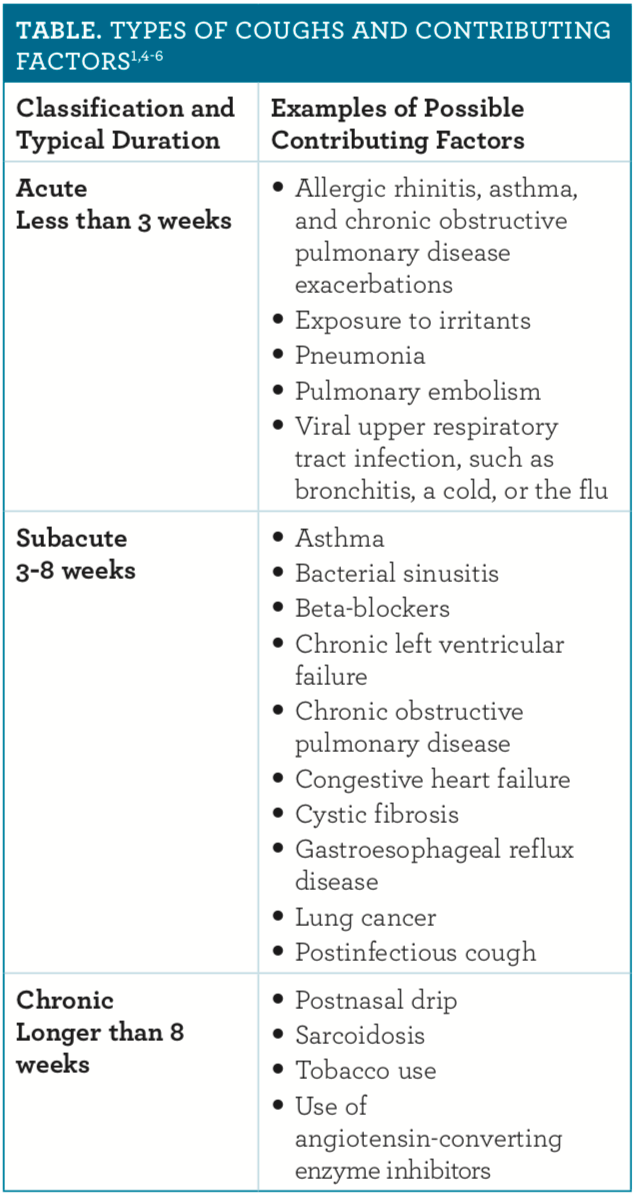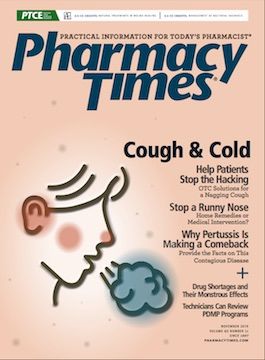Help Patients Relieve a Nagging Cough
Assess allergy, medical, medication histories to ensure self-treatment is appropriate.
It is that time of year again. Patients are seeking symptomatic relief from pesky coughs caused by colds and the flu.
A cough is a common symptom for which patients may seek medical care at emergency departments and urgent care clinics. However, some patients initially elect to self-treat with a nonprescription cough product.1 Selecting an OTC remedy may be daunting, particularly for patients with preexisting medical conditions or who take other medications. Pharmacists are in a key position to aid patients in selecting an OTC cough product when appropriate. They can also encourage patients to seek further medical care when necessary, particularly if the origin of the cough is unidentified or the patient is displaying signs of a respiratory tract infection or experiencing a persistent cough. Pharmacists can also identify patients who may experience a cough, because of medical conditions or the use of certain pharmacological agents, and counsel them on how to resolve the cough.
RECENT NEWS
On September 1, 2019, Texas joined the 18 other states that have implemented laws restricting access to OTC cough medicines that contain dextromethorphan to those younger than 18 years. Stores caught violating the new law will first receive a warning. The fines that follow are $150 for a second violation and $250 for every subsequent violation.2
The results of a recent study show that following the 2008 FDA advisory to decrease the use of cold and cough medicines in pediatric patients, physicians are more likely to recommend antihistamines and less likely to recommend the former in this patient population.3
OVERVIEW AND WHEN TO SELF-TREAT
Although most coughs resolve on their own, they can still negatively affect overall quality of life by interfering with sleep and causing chest pain, exhaustion, fatigue, headaches, hoarseness, musculoskeletal discomfort or pain, and urinary incontinence.1 A cough can be classified as acute or chronic and non- productive or productive, as well as be the result of an infection, certain medical conditions, exposure to allergens or irritants, or use of certain pharmacological agents (table).1,4-6

In addition to advising patients about OTC cough medications, pharmacists are in a pivotal position to identify those who may be abusing cough syrup containing dextromethorphan, also known as “robotripping.”7 Dextromethorphan is one of the 2 most commonly abused OTC medications, especially among teens, according to the National Institute on Drug Abuse (NIDA).7 An estimated 3% of high school seniors reported taking large doses of cough medicine to get high, according to the results of a 2017 study from the NIDA.2
NONPRESCRIPTION COUGH MEDICATIONS
For the self-treatment of coughs, available nonprescription products include oral antitussives (cough suppressants), protussives (expectorants), and topical antitussives. These agents are available as combination or single-entity products that contain both antitus- sive and protussive agents.1,4
The available FDA-approved OTC oral antitussives include codeine, dextromethorphan, and diphenhydramine in various dosage formulations.1 At antitussive doses, codeine is classified as a Schedule V narcotic and is available without a prescription in many states.1 Guaifenesin is the only FDA-approved expectorant.1 Camphor and menthol, the only 2 FDA-approved topical antitussives, are found in inhalation form and ointments.1
ROLE OF THE PHARMACIST
Prior to making any recommendations, pharmacists should ascertain if self-treatment is appropriate and assess a patient’s allergy and medical histories, as well as their medication profile, to check for possible drug contraindications or interactions. Lactating and pregnant women and those with chronic medical conditions or who take other medications should always consult with their primary health care providers before using any nonprescription cough medications.
Because a cough is a symptom of many acute and chronic medical conditions, self-treatment may delay identification of the underlying cause and thus proper treatment.1 Encourage individuals with signs of a chronic cough to seek further medical assessment, especially if the cough is not improving or is worsening and/or the source is unidentified.
An excellent patient education tool is the Do’s and Don’ts of Cough and Cold Medicines.8
Yvette C. Terrie, BSPharm, RPh, is a consulting pharmacist and a medical writer in Haymarket, Virginia.
REFERENCES
- Tietze K. Cough. In: Krinsky D, Berardi R, Ferreri S, et al, eds. Handbook of Nonprescription Drugs. 19th ed. Washington, DC: American Pharmacists Association; 2018. 217-230.
- Byrne E. Texas law will outlaw minors from buying popular cough medicine. American Pharmacists Association website. pharmacist.com/article/texas-law-will-outlaw-minors-buying-popular-cough-medicine. Published May 30, 2019. Accessed September 1, 2019
- Horton DB, Gerhard T, Strom BL. Trends in Cough and cold medicine recommendations for children in the United States 2002-2015 [published online July 29, 2019]. JAMA Pediatr. doi: 10.1001/jamapediatrics.2019.2252.
- Dlugosz CK. Cough. In: Dlugosz, ed.The Practitioner’s Quick Reference to Nonprescription Drugs. 2nd ed. Washington, DC: American Pharmacists Association; 2012:75-8
- Sharma S, Hashmi MF, Alhajjaj MS. Cough. National Center for Biotechnology Information website. ncbi.nlm.nih.gov/books/NBK493221/. Published June 22, 2019. Accessed September 5, 2019.
- Chen HH. Chronic cough. Medscape website. emedicine.medscape.com/article/1048560-overview#a3. Updated December 5, 2018. Accessed September 1, 2019.

